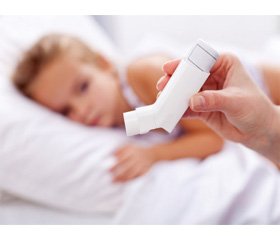Журнал «Здоровье ребенка» 8 (59) 2014
Вернуться к номеру
Features atopic reactivity in scool-age children with with severe asthma
Авторы: U.I. Marusyk - Bukovinian State Medical University, Department of Pediatrics and pediatric infectious diseases; O.K. Koloskova - Head of Department – professor, MD, Department of nursing and higher nursing education, Chernivtsi
Рубрики: Педиатрия/Неонатология
Разделы: Клинические исследования
Версия для печати
Introduction. According to published data in 70-95% of children developing asthma that is difficult to treat. The ineffectiveness of inhaled corticosteroids, which is the basis of basic therapy of asthma, can be due, perhaps, the presence of different phenotypes of the disease, including phenotype “severe asthma”. Assigning controlling asthma therapy in children should be considered at its phenotype, characterized by different mechanisms of the disease, but, is almost identical clinical symptoms.
The arm of the research: to establish the diagnostic value of indicators atopic reactivity in the verification severe asthma phenotype to improve treatment outcomes in school-age children.
Methods: 60 school-age children with asthma examined in pulmonology department of Chernivtsi Regional Clinical Hospital. Over the course of the disease patients were divided into two clinical groups. The first clinical group consisted of 30 patients who had been registered severe asthma. The second clinical group formed 30 students who have asthma defined moderate. For the main clinical signs were matched comparison group.
All children performed immunological blood test II - III levels. Contents of serum total immunoglobulin E (IgE), IL-4 and IL-5 were determined by enzyme immunoassay (EIA). Identification of immediate type skin sensitivity to standard Nonbacterial allergens was performed by intradermal tests. Atopy household, epidermal, pollen and food allergens were used for research.
Results. The concentration of IL-4 in serum children first clinical group was 10,6 ± 2,1 pg/ml, and in those of the second group - 7,2 ± 2,5 pg/ml (P> 0,05). The average content of interleukin-5 in the clinical group was 35,8 ± 15,7 pg/ml and 8,6 ± 4,3 pg/ml (P>0,05), respectively. Almost every third patient first clinical group (36,4%) recorded significantly increased content of IL-4 (more than 10,0 pg/ml), whereas in the second group surveyed - only 15,5% of cases (Pφ<0,05).
Concentration of IgE, which exceeded 545,3 IU/ml, recorded in 56,6% of children first clinical group and only 43,4% of cases in the second (P>0,05) the comparison group.
In patients with severe asthma cases occurred significantly more frequently increased sensitivity of the skin to household allergens relative to the second group. Thus, the amount of hyperemia more than 15,0 mm was recorded in 81,5% of the first group and only 51,9% of persons (Rφ<0,05) second.
Conclusions. 1. Due to the low sensitivity of the content of IL-4 and -5 in serum them impractical for use on their own verification phenotype of severe asthma. 2. The concentration of immunoglobulin E in excess of 545,3 IU/ml, in 2 times increased the chances of the presence of severe asthma in children. 3. Increased sensitivity to domestic allergens (hyperemia over 15,0 mm) allows to verify the specificity of 81,5% severe asthma and personalize treatment policy in these patients.
1. Faktory ryzyku vynyknennya bronkhial'noyi astmy u ditey / V.P. Kostromina, O. O. Rechkina K. O. Mel'nyk [ta in.] // Astma ta alerhiya. – 2013. – #2. – S. 21 – 24.
2. Hnateyko O.Z. Deyaki aspekty problemy rann'oyi diahnostyky bronkhial'noyi astmy v ditey / O.Z. Hnateyko, O.M. Sadova // Zdorov'e rebenka. – 2009. – #5 (20). – S. 34 – 38.
3. Umanets' T.R. Kliniko-anamnestychni osoblyvosti fenotypiv bronkhial'noyi astmy u ditey / T.R. Umanets' // Perynatolohyya y pedyatryya – 2011 - #2 (46). – S. 69-71.Green R.H. Stability of inflammatory phenotypes in asthma / R.H. Green, I. Pavord // Thorax. – 2012. – №67. – pp 665-667.
4. Kostromina V, Rechkina O, Mel`ny`k K Risk factor for asthma in children. Astma ta alergiya 2013; 2: 21–24.
5. Soyer O, Akdis M, Ring J. Mechanisms of peripheral tolerance to allergens. Allergy 2013; 68: 161-170.
6. Lotvall J, Akdis C, Bacharier L Asthma endotypes: A new approach to classification of disease entities within the asthma syndrome. J Allergy clin immunol. 2011; 127, N2: 355-360.
7. Bourdin A, Kleis S, Chakra M Limited Short-term Steroid Responsiveness Is Associated With Thickening of Bronchial Basement Membrane in Severe Asthma. Chest 2012; 141(6): 1504–1511.
8. Umanecz` T Clinical and anamnestic features phenotypes of asthma in children. Perinatologiya i pediatriya 2011; 2(46): 69-71.
9. Green R, Pavord I Stability of inflammatory phenotypes in asthma. Thorax 2012; 67: 665-667.
10. Soyer O, Akdis M, Ring J Mechanisms of peripheral tolerance to allergens. Allergy 2013; 68: 161-170.
11. Silvestri M, Pistorio A, Battistini E IgE in childhood asthma: relevance of demographic characteristics and polysensitisation. Arch Dis Child 2010; 95: 979—984.
12. Waserman S, Nair P, Snider D Local and systemic immunological parameters assjciated with remission of asthma symptoms in children. Allergy, asthma and clinical immunology 2012; 8, Is.16: 1-14.
13. Silvestri M, Pistorio A, Battistini E IgE in childhood asthma: relevance of demographic characteristics and polysensitisation. Arch Dis Child 2010; 95: 979—984.
14. Soyer O, Akdis M, Ring J Mechanisms of peripheral tolerance to allergens. Allergy 2013; 68: 161-170.

